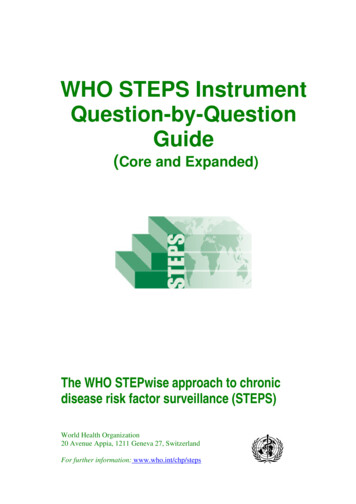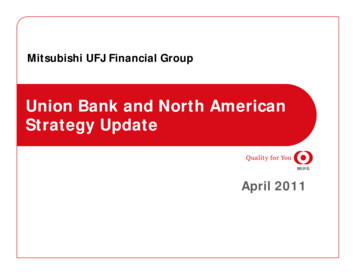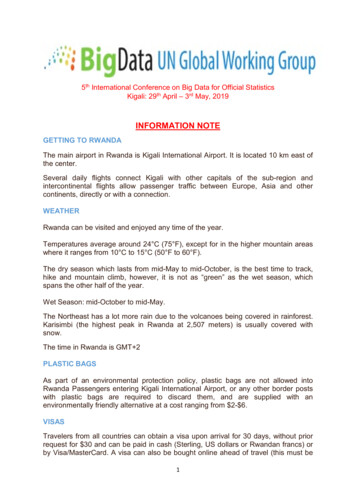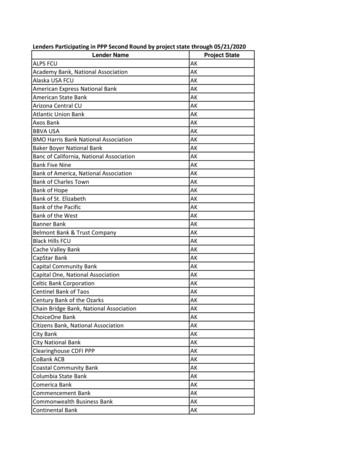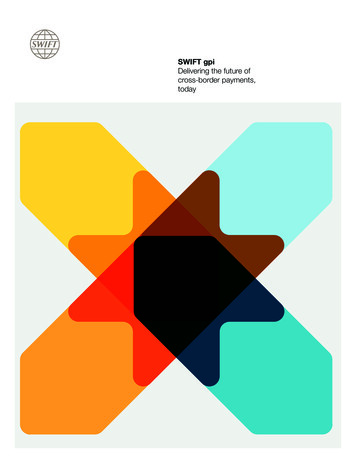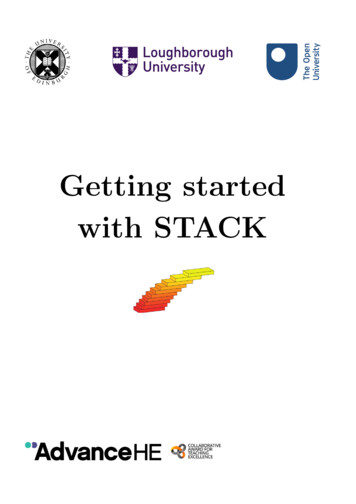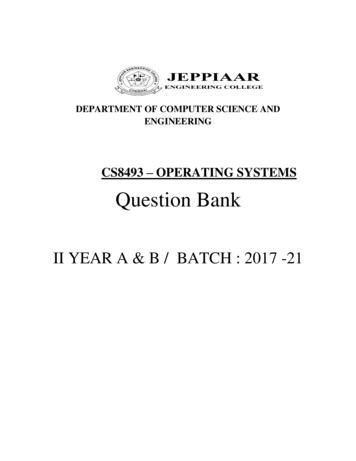
Transcription
DEPARTMENT OF COMPUTER SCIENCE ANDENGINEERINGCS8493 – OPERATING SYSTEMSQuestion BankII YEAR A & B / BATCH : 2017 -21
Vision of InstitutionTo build Jeppiaar Engineering College as an Institution of Academic Excellence in Technicaleducation and Management education and to become a World Class University.Mission of InstitutionM1To excel in teaching and learning, research and innovation by promoting theprinciples of scientific analysis and creative thinkingM2To participate in the production, development and dissemination of knowledge andinteract with national and international communitiesM3To equip students with values, ethics and life skills needed to enrich their lives andenable them to meaningfully contribute to the progress of societyM4To prepare students for higher studies and lifelong learning, enrich them with thepractical and entrepreneurial skills necessary to excel as future professionals andcontribute to Nation’s economyProgram Outcomes (POs)PO1PO2PO3PO4PO5PO6PO7PO8PO9Engineering Knowledge: Apply the Knowledge of mathematics, science,engineering fundamentals, and an engineering specialization to the solution ofcomplex engineering problems.Problem analysis: Identify, formulate, review research literature, and analyzecomplex engineering problems reaching substantiated conclusions using firstprinciples of mathematics, natural sciences, and engineering sciences.Design/development of solutions: Design solutions for complex engineeringproblems and design system components or processes that meet the specifiedneeds with appropriate consideration for the public health and safety, and thecultural, societal, and environmental considerationsConduct investigations of complex problems: Use research-based Knowledgeand research methods including design of experiments, analysis and interpretationof data, and synthesis of the information to provide valid conclusions.Modern tool usage: Create, select, and apply appropriate techniques, resources,and modern engineering and IT tools including prediction and modeling tocomplex engineering activities with an understanding of the limitations.The engineer and society: Apply reasoning informed by the contextualKnowledge to assess societal, health, safety, legal and cultural issues and theconsequent responsibilities relevant to the professional engineering practice.Environment and sustainability: Understand the impact of the professionalengineering solutions in societal and environmental contexts, and demonstrate theKnowledge of, and need for sustainable development.Ethics: Apply ethical principles and commit to professional ethics andresponsibilities and norms of the engineering practice.Individual and team work: Function effectively as an individual, and as amember or leader in diverse teams, and in multidisciplinary settings.
PO10PO11PO12Communication: Communicate effectively on complex engineering activitieswith the engineering community and with society at large, such as, being able tocomprehend and write effective reports and design documentation, make effectivepresentations, and give and receive clear instructions.Project management and finance: Demonstrate Knowledge and understandingof the engineering and management principles and apply these to one’s own work,as a member and leader in a team, to manage projects and in multidisciplinaryenvironments.Life-long learning: Recognize the need for, and have the preparation and abilityto engage in independent and life-long learning in the broadest context oftechnological change.Vision of DepartmentTo emerge as a globally prominent department, developing ethical computer professionals,innovators and entrepreneurs with academic excellence through quality education and research.Mission of DepartmentM1To create computer professionals with an ability to identify and formulate theengineering problems and also to provide innovative solutions through effectiveteaching learning process.M2To strengthen the core-competence in computer science and engineering and to createan ability to interact effectively with industries.M3To produce engineers with good professional sKills, ethical values and life skills for thebetterment of the society.M4To encourage students towards continuous and higher level learning on technologicaladvancements and provide a platform for employment and self-employment.Program Educational Objectives (PEOs)PEO1To address the real time complex engineering problems using innovative approachwith strong core computing skills.PEO2To apply core-analytical Knowledge and appropriate techniques and providesolutions to real time challenges of national and global societyPEO3Apply ethical Knowledge for professional excellence and leadership for thebetterment of the society.PEO4Develop tteremploymentand
CS8493 OPERATING SYSTEMSLTPC3003OBJECTIVES: To understand the basic concepts and functions of operating systems.To understand Processes and ThreadsTo analyze Scheduling algorithms.To understand the concept of Deadlocks.To analyze various memory management schemes.To understand I/O management and File systems.To be familiar with the basics of Linux system and Mobile OS like iOS and Android.UNIT I OPERATING SYSTEM OVERVIEW7Computer System Overview-Basic Elements, Instruction Execution, Interrupts, MemoryHierarchy, Cache Memory, Direct Memory Access, Multiprocessor and Multicore Organization.Operating system overview-objectives and functions, Evolution of Operating System.- ComputerSystem Organization Operating System Structure and Operations- System Calls, SystemPrograms, OS Generation and System Boot.UNIT II PROCESS MANAGEMENT11Processes – Process Concept, Process Scheduling, Operations on Processes, Inter-processCommunication; CPU Scheduling – Scheduling criteria, Scheduling algorithms, Multipleprocessor scheduling, Real time scheduling; Threads- Overview, Multithreading models,Threading issues; Process Synchronization – The critical-section problem, Synchronizationhardware, Mutex locks, Semaphores, Classic problems of synchronization, Critical regions,Monitors; Deadlock – System model, Deadlock characterization, Methods for handlingdeadlocks, Deadlock prevention, Deadlock avoidance, Deadlock detection, Recovery fromdeadlock.UNIT III STORAGE MANAGEMENT9Main Memory – Background, Swapping, Contiguous Memory Allocation, Paging, Segmentation,Segmentation with paging, 32 and 64 bit architecture Examples; Virtual Memory – Background,Demand Paging, Page Replacement, Allocation, Thrashing; Allocating Kernel Memory, OSExamples.UNIT IV FILE SYSTEMS AND I/O SYSTEMS9Mass Storage system – Overview of Mass Storage Structure, Disk Structure, Disk Schedulingand Management, swap space management; File-System Interface – File concept, Accessmethods, Directory Structure, Directory organization, File system mounting, File Sharing andProtection; File System Implementation- File System Structure, Directory implementation,Allocation Methods, Free Space Management, Efficiency and Performance, Recovery; I/OSystems – I/O Hardware, Application I/O interface, Kernel I/O subsystem, Streams,Performance.UNIT V CASE STUDY9Linux System – Design Principles, Kernel Modules, Process Management, Scheduling, MemoryManagement, Input-Output Management, File System, Inter-process Communication; Mobile
OS – iOS and Android – Architecture and SDK Framework, Media Layer, Services Layer, CoreOS Layer, File System.TOTAL : 45 PERIODSTEXT BOOK :1. Abraham Silberschatz, Peter Baer Galvin and Greg Gagne, ―Operating SystemConcepts‖, 9th Edition, John Wiley and Sons Inc., 2012.Course Outcomes (COs)C212.1Analyze various scheduling algorithms.C212.2Understand deadlock, prevention and avoidance algorithms.C212.3Compare and contrast various memory management schemes.C212.4Understand the functionality of file systems.C212.5Perform administrative tasks on Linux Servers. Compare iOS and AndroidOperating Systems.BLOOM TAXANOMY LEVELSBTL1: Remembering., BTL2: Evaluating., BTL3: Analyzing., BTL4: Applying., BTL5: Understanding.,BTL6: Creating
UNIT NOUNIT -IUNIT -IIUNIT -IIIUNIT -IVUNIT -VINDEXTEXT/ REFERENCE BOOKAbraham Silberschatz, Peter Baer Galvin and Greg Gagne,―Operating System Concepts‖, 9th Edition, John Wiley and SonsInc., 2012.Abraham Silberschatz, Peter Baer Galvin and Greg Gagne,―Operating System Concepts‖, 9th Edition, John Wiley and SonsInc., 2012.Abraham Silberschatz, Peter Baer Galvin and Greg Gagne,―Operating System Concepts‖, 9th Edition, John Wiley and SonsInc., 2012.Abraham Silberschatz, Peter Baer Galvin and Greg Gagne,―Operating System Concepts‖, 9th Edition, John Wiley and SonsInc., 2012.Abraham Silberschatz, Peter Baer Galvin and Greg Gagne,―Operating System Concepts‖, 9th Edition, John Wiley and SonsInc., 2012.PAGENO4-98103-422455-572575-688695-795
UNIT IOPERATING SYSTEMS OVERVIEWComputer System Overview-Basic Elements, Instruction Execution, Interrupts, MemoryHierarchy, Cache Memory, Direct Memory Access, Multiprocessor and Multicore Organization.Operating system overview-objectives and functions, Evolution of Operating System.Computer System Organization-Operating System Structure and Operations- System Calls,System Programs, OS Generation and System Boot.PART at are the objectives of operating system?(AU: April/May 2010) (AU: May/June 2012)(April/May 2017)Ans: An operating system is a program thatmanages the computer hardware. it act as anintermediate between a users of a computer and thecomputer hardware. It controls and coordinates theuse of the hardware among the various applicationprograms for the various users.2COBloomsTaxanomyLevelWhat are the advantages of peer-to-peer systemsover client-server systems? (May/June 2016)Ans: 3The main advantage of peer to peer networkis that it is easier to set up In peer-to-peer networks all nodes are act asserver as well as client therefore no need ofdedicated server. The peer to peer network is less expensive. Peer to peer network is easier to set up anduse this means that you can spend less timein the configuration and implementation ofpeer to peer network. It is not require for the peer to peer networkto use the dedicated server computer. Anycomputer on the network can function asboth a network server and a user workstationWhat is the purpose of system programs/systemcalls?(May/June 2016) (Apr/May 2018)Ans: System programs can be thought of as bundlesof useful system calls. They provide basicfunctionality to users so that users do not need to
write their own programs to solve commonproblems.4How does an interrupt differtrap?(Nov/Dec 2016)(Apr/May 2018)fromaAns: An interrupt is a hardware-generated signalthat changes the flow within the system. A trap is asoftware-generated TL-1An interrupt can be used to signal the completion ofI/O so that the CPU doesn't have to spend cyclespolling the device. A trap can be used to catcharithmetic errors or to call system routines5What are disadvantages of multi-processorsystems?(Nov/Dec 2016)Ans:6 Complex Operating System is required Large main memory required Very ng? If so, how?(April/May 2015)Ans: Main difference between multiprogrammingand time sharing is that multiprogramming is theeffective utilization of CPU time, by allowingseveral programs to use the CPU at the same timebut time sharing is the sharing of a computingfacility by several users that want to use the samefacility at the same time.7Why API’s need to be used rather than systemcall? (April/May2015)Ans: There are four basic reasons:1) System calls differ from platform to platform. Byusing a stable API, it is easier to migrate yoursoftware to different platforms.2) The operating system may provide newerversions of a system call with enhanced features.The API implementation will typically also beupgraded to provide this support, so if you call theAPI, you'll get it.3) The API usually provides more usefulfunctionality than the system call directly. If you
make the system call directly, you'll typically haveto replicate the pre-call and post-call code that'salready implemented by the API. (For example the'fork' API includes tons of code beyond just makingthe 'fork' system call. So does 'select'.)4) The API can support multiple versions of theoperating system and detect which version it needsto use at run time. If you call the system directly,you either need to replicate this code or you canonly support limited versions.8Compare and contrastmemory.(Nov/Dec 2015)DMAandcacheAns: DMA(Direct Memory Access):Directmemory access (DMA) is a feature of computersystems that allows certain hardware subsystems toaccess main memory (Random-access memory),independent of the central processing unit (CPU).C212.1BTL-2C212.1BTL-4C212.1BTL-2Cache Memory: A cache is a smaller, fastermemory, closer to a processor core, which storescopies of the data from frequently used mainmemory locations.So, both DMA and cache are used for increasing thespeed of memory access.9Distinguish between batch systems and timesharing systems.(Nov/Dec 2015)Ans:Batch System10Time sharing systemJobs or work is keep inorder and jobs are runone after the otherThe tasks are givenspecific time andoperating systemswitches betweendifferent tasks.there won’t be any userinteractionsuser interaction isinvolved in theprocessingCompare tightly coupled systems and looselycoupled systems?Ans:
Loosely coupled systems:Each processor has its own local memory. Eachprocessor can communicate with other all throughcommunication linesTightly coupled systems:Common memory is shared by many processors Noneed of any special communication lines.11What is real time system?Ans: A real time system has well defined, fixedtime constraints. Processing must be done within thedefined constraints, or the system will fail. It isoften used as a control device in a 1BTL-1C212.1BTL-1What is process control block?Ans: Each process is represented in the OS by aprocess control block. It contain many pieces ofinformation associated with a specific process.16BTL-1Define: processAns: A process is a program in execution. It is anactive entity and it includes the process stack,containing temporary data and the data sectioncontains global variables.15C212.1What do you mean by system calls?Ans: System calls provide the interface between aprocess and the operating system. When a systemcall is executed, it is treated as by the hardware assoftware interrupt.14BTL-1What are privileged instructions?Ans: Some of the machine instructions that maycause harm to a system are designated as privilegedinstructions. The hardware allows the privilegedinstructions to be executed only in monitor mode.13C212.1What is scheduler?Ans: A process migrates between the variousscheduling queues through out its life time. The OSmust select processes from these queues in somefashion. This selection process is carried out by ascheduler.
17What are the use of job queues, ready queuesand device queues?Ans: As a process enters a system they are put in toa job queue. This queues consist of all jobs in thesystem. The processes that are residing in mainmemory and are ready and waiting to execute arekept on a list called ready queue. The list ofprocesses waiting for particular I/O devices kept inthe device .1BTL-6What is meant by context switch?Ans: Switching the CPU to another process requiressaving the state of the old process and loading thesaved state for the new process. This task is knownas context switch.19C212.1Discuss the difference between symmetric andasymmetric multiprocessingAns:Symmetric multiprocessing (SMP), in which eachprocessor runs an identical copy of the operatingsystem and these copies, communicate with oneanother as needed. Asymmetric multiprocessing,in which each processor is assigned a specific task.The master processor controls the system; the otherprocessor looks the Ans: Multiprogramming makes efficient use of theCPU by overlapping the demands for the CPU andits I/O devices from various users. It attempts toincrease CPU utilization by always havingsomething for the CPU to execute.21Discuss the main advantages of layered approachto system design?Ans: As in all cases of modular design, designingan operating system in a modular way has severaladvantages. The system is easier to debug andmodify because changes affect only limited sectionsof the system rather than touching all sections of theoperating system. Information is kept only where itis needed and is accessible only within a definedand restricted area, so any bugs affecting that datamust be limited to a specific module or layer.
22List the advantage of multiprocessor 2C212.1BTL-3What is bootstrap program?Ans: A bootstrap is the program that initializes theoperating system (OS) during startup.26C212.1Identify the difference between mainframe anddesktop operating system.Ans: The design goals of operating systems forthose machines are quite different. PCs areinexpensive, so wasted resources like CPU cyclesare inconsequential. Resources are wasted toimprove usability and increase software userinterface functionality. Mainframes are the opposite,so resource use is maximized, at the expensive ofease of use.25BTL-4 Increased throughput. Economy of scale. Increased reliability.Define inter process communication.Ans: Inter process communication provides amechanism to allow the co-operating process tocommunicate with each other and synchronies theiractions without sharing the same address space. It isprovided a message passing system.24C212.1Illustrate the different interrupt clauses.Ans: 27Hardware interruptsSoftware interruptsIdentify what virtual machine is and what arethe advantages virtual machines.Ans: Virtual Machine is a completely separateindividual operating system installation on yourusual operating system. It is implemented bysoftware emulation and hardware virtualization.Advantages: Multiple OS environments can existsimultaneously on the same machine,isolated from each other;
28Virtual machine can offer an instruction setarchitecture that differs from realcomputer's; Easy maintenance, application provisioning,availability and convenient recovery.Distinguish between hard real time systems andsoft real time systems.Ans:A Hard Real-Time System guarantees that criticaltasks complete on 212.1BTL-4A Soft Real Time System where a critical real-timetask gets priority over other tasks and retains thatpriority until it completes.29Summarize the functions of DMA.Ans: Direct memory access (DMA) is a method thatallows an input/output (I/O) device to send orreceive data directly to or from the main memory,bypassing the CPU to speed up memory operations.The process is managed by a chip known as a DMAcontroller (DMAC).30Illustrate the use of fork and exec system calls.Ans: fork() is the name of the system call that theparent process uses to "divide" itself ("fork") intotwo identical processes. After calling fork(), theCreatingd child process is an exact copy of theparent except for the return value.When the child process calls exec(), all data in theoriginal program is lost, and it is replaced with arunning copy of the new program. This is known asoverlaying.31Define: Clustered systems.Ans: A computer cluster is a set of loosely or tightlyconnected computers that work together so that, inmany respects, they can be viewed as a singlesystem.32Some computer systems do not provide aprivileged mode of operation in hardware. Is itpossible to construct a secure operating systemfor these computer systems? (Nov/Dec 2018)
Ans: An operating system for a machine of this typewould need to remainin control (or monitor mode) at all times. This couldbe accomplished by twomethods:a. Software interpretation of all user programs (likesome BASIC, Java, andLISP systems, for example).interpreter would provide, inThesoftwaresoftware, what the hardware does not provide.b. Require meant that all programs be written inhigh‐level languages so thatall object code is compiler‐produced. The compilerwould generate (either in‐ine or by function calls) the protection checks thatthe hardware is missing.33Can traps be generated intentionally by a userprogram? If so, for what purpose? (Nov/Dec2018)Ans: A trap is a software‐generated interrupt. Aninterrupt can be used to signalC212.1BTL-1C212.1BTL-1the completion of an I/O to obviate the need fordevice polling. A trap can be used to call operatingsystem routines or to catch arithmetic errors.34What are the three main purposes of anoperating system?Ans:The three main puropses are: To provide an environment for a computer user toexecute programs on computer hardware in aconvenient and efficient manner. To allocate the separate resources of the computeras needed to solve the problem given. Theallocation process should be as fair and efficient aspossible. As a control program it serves two majorfunctions: (1) supervision of the execution of user
programs to prevent errors and improper use of thecomputer, and (2) management of the operation andcontrol of I/O devices.35What is the purpose of system calls?Ans:System calls allow user-level processes torequest services of the operating L-1What are the five major activities of an operatingsystem with regard to process management?Ans:The five major activities are:a. The creation and deletion of both user and systemprocessesb. The suspension and resumption of processesc. The provision of mechanisms for processsynchronizationd. The provision of mechanisms for processcommunicatione. The provision of mechanisms for deadlockhandling37What are the three major activities of anoperating system with regard to memorymanagement?Ans:The three major activities are:a. Keep track of which parts of memory arecurrently being used and by whom.b. Decide which processes are to be loaded intomemory when memory space becomes available.c. Allocate and deallocate memory space as needed.38What are the three major activities of anoperating system with regard to secondarystorage management?Ans:The three major activities are:
Free-space management. Storage allocation. Disk scheduling39What is an Operating system?Ans:An operating system is a program that managesthe computer hardware. It also provides a basis forapplication programs and act as an intermediarybetween a user of a computer and the computerhardware. It controls and coordinates the use of thehardware among the variousapplication programsfor the various -1C212.1BTL-1List the services provided by an OperatingSystem?Ans:Program executionI/O OperationFile-System manipulationCommunicationsError detection41What is the Kernel?Ans:A more common definition is that the OS is theone program running at all times on the computer,usually called the kernel, with all else beingapplication programs.42What is meant by Mainframe Systems?Ans:Mainframe systems are the first computersdeveloped to tackle many commercial and scientificapplications. These systems are developed from thebatch systems and then multiprogramming systemand finally time sharing systems.43What is Multiprocessor System?Ans:Multiprocessor systems have systems morethan one processor for communication, sharing thecomputer bus, the memory, clock & peripheral
devices.44What are the advantages of multiprocessors?Ans:Increased TL-1C212.1BTL-1C212.1BTL-1Economy of scaleIncreased reliability45What is the use of Fork and Exec System Calls?Ans:Fork is a System calls by which a new processis created. Exec is also a System call, which is usedafter a fork by one of the two processes to replacethe process memory space with a new program.46What are the five major categories of SystemCalls?Ans:Process ControlFile-managementDevice-managementInformation maintenanceCommunications47What are the modes of operation in HardwareProtection?Ans:User ModeMonitor Mode48What is meant by Batch Systems?Ans:Operators batched together jobs with similarneeds and ran through the computer as a group .Theoperators would sort programs into batches withsimilar requirements and as system becomeavailable, it would run each batch.49List the privileged instruction.
Ans:50a. Set value of timer.b. Clear memory.c. Turn off interrupts.d. Modify entries in device-status tabe. Access I/O device.What are the Components of a ComputerSystem?Ans:Application 1C212.1BTL-5System ProgramOperating SystemComputer HardwarePART B & C1Explain different operating system structures withneat sketch. (Nov/Dec 2015) (Apr/May 2017)(Apr/May 2018)Refer page no 55 – 61 from text book “AbrahamSilberschatz, Peter Baer Galvin and Greg Gagne,“Operating System Concepts”, 9th Edition, JohnWiley and Sons Inc., 2012”.2Explain the various types of system calls withexamples. (May/June 2015) (Nov/Dec 2015)(Apr/May 2017) (Nov/Dec 2018)Refer page no 62 – 73 from text book “AbrahamSilberschatz, Peter Baer Galvin and Greg Gagne,“Operating System Concepts”, 9th Edition, JohnWiley and Sons Inc., 2012”.3What are the basic functions of OS and DMA(Nov/Dec 2015) (Apr/May2017)Refer page no 464 – 466 from text book “AbrahamSilberschatz, Peter Baer Galvin and Greg Gagne,“Operating System Concepts”, 9th Edition, JohnWiley and Sons Inc., 2012”.4Explain the concept of multiprocessorMulticore organization. (Apr/May 2017)andRefer page no 14 – 16 from text book “AbrahamSilberschatz, Peter Baer Galvin and Greg Gagne,
“Operating System Concepts”, 9th Edition, JohnWiley and Sons Inc., 2012”.5What are the advantages and disadvantages of usingthe same system call interface for both files anddevices. (Nov/Dec efer page no 30 –31 from text book “AbrahamSilberschatz, Peter Baer Galvin and Greg Gagne,“Operating System Concepts”, 9th Edition, JohnWiley and Sons Inc., 2012”.C212.1BTL-5List the various services provided by operatingsystems. (Nov/Dec 2016)C212.1BTL-1Refer page no 64 – 71 from text book “AbrahamSilberschatz, Peter Baer Galvin and Greg Gagne,“Operating System Concepts”, 9th Edition, JohnWiley and Sons Inc., 2012”.6Describe the difference between symmetric andasymmetricmultiprocessing.Discusstheadvantages and disadvantages of multiprocessorsystems. (May/June 2016) (Nov/Dec 2016)Refer page no 12 – 18 from text book “AbrahamSilberschatz, Peter Baer Galvin and Greg Gagne,“Operating System Concepts”, 9th Edition, JohnWiley and Sons Inc., 2012”.7Discuss in detail about Distributed systems.(May/June 2016)Refer page no 37 – 38 from text book “AbrahamSilberschatz, Peter Baer Galvin and Greg Gagne,“Operating System Concepts”, 9th Edition, JohnWiley and Sons Inc., 2012”.8Demonstrate the three methods for passingparameters to the OS with examples. (May/June2016)Refer page no 120 – 128 from text book “AbrahamSilberschatz, Peter Baer Galvin and Greg Gagne,“Operating System Concepts”, 9th Edition, JohnWiley and Sons Inc., 2012”.910Explain how protection is provided for the hardwareresources by the operating system. (Nov/Dec 2016)
(Apr/May 2018)Refer page no 53-56 from text book “AbrahamSilberschatz, Peter Baer Galvin and Greg Gagne,“Operating System Concepts”, 9th Edition, JohnWiley and Sons Inc., 2012”.11Discuss the DMA driven data transfer technique.(May/June 2015)Refer page no 12, 583-585 from text book“Abraham Silberschatz, Peter Baer Galvin and GregGagne, “Operating System Concepts”, 9th Edition,John Wiley and Sons Inc., 2012”.12Discuss about the evolution of virtual machines.Also explain how virtualization could beimplemented in operating systems. (May/June2015)Refer page no 40 – 41 from text book “AbrahamSilberschatz, Peter Baer Galvin and Greg Gagne,“Operating System Concepts”, 9th Edition, JohnWiley and Sons Inc., 2012”.13C212.1BTL-6BTL-5 &C212.1BTL-6With neat sketch, discuss about computer systemoverview. (Nov/Dec 2015)Refer page no 27 – 34 from text book “AbrahamSilberschatz, Peter Baer Galvin and Greg Gagne,“Operating System Concepts”, 9th Edition, JohnWiley and Sons Inc., 2012”.C212.1BTL-6Give reasons why caches are useful. What problemsdo they solve and cause? If a catch can be made aslarge as the device for which it is catching why notmake it that large and eliminate the device?(Apr/May 2018)C212.1BTL-615Discuss the functionality of system boot withrespect to an operating system. (Nov/Dec 2018)C212.1BTL-516Discuss the essential properties of the followingtypes of systems, (Nov/Dec 2018)C212.1BTL-514i) Time sharing systems ii) Multi-processor systemsiii) Distributed systems
UNIT IIPROCESS MANAGEMENTProcesses-Process Concept, Process Scheduling, Operations on Processes, InterprocessCommunication; Threads- Overview, Multicore Programming, Multithreading Models;Windows 7 – Thread and SMP Management. Process Synchronization – Critical SectionProblem, Mutex Locks, Semophores, Monitors; CPU Scheduling and Deadlocks.PART – AS.BloomsNoQuestionCOTaxanomy.Level1Compare and contrast Single-threaded andmulti-threaded process. (Apr/May 2017)Ans:Single-threading is the processing of onecommand/ process at a time. Whereas multithreading is a widespread programming andexecution model that allows multiple threads to existwithin the context of one process. These threadsshare the process's resources, but are able to BTL-4Priority inversion is a condition that occurs inreal time systems – Analyzing on this statement.(Apr/May 2017)Ans: Priority inversion is a problem that occurs inconcurrent processes when low-priority thre
Systems - I/O Hardware, Application I/O interface, Kernel I/O subsystem, Streams, Performance. UNIT V CASE STUDY 9 Linux System - Design Principles, Kernel Modules, Process Management, Scheduling, Memory . ―Operating System Concepts‖, 9th Edition, John Wiley and Sons Inc., 2012. 695-795 . UNIT I




